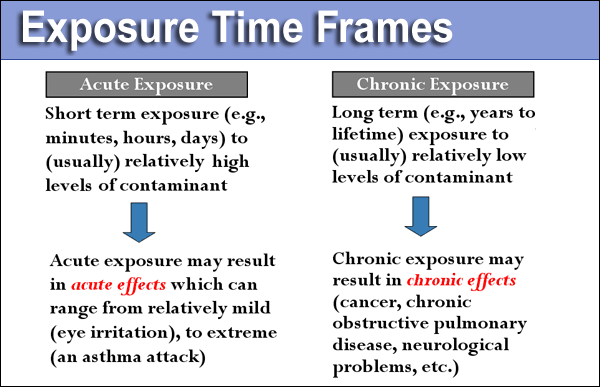Coming in contact with air toxics may cause serious health risks. Exposure refers to the way(s) in which a person may come in contact with a chemical. It also refers to the length of time of the exposure. Primary ways people can be exposed to chemicals in the environment include:
- Breathing in chemical vapors and dust (inhalation),
- Drinking or eating the chemical (ingestion), and,
- Absorbing the chemical through the skin (absorption).
Acute and Chronic Exposure and Effects
Evaluating exposure commonly includes determining if inhaling, ingesting or absorbing a chemical may cause acute (immediate) effects from acute (short-term) exposure and/or chronic (long-term) effects from chronic exposure (continuous and repeated exposure over a longer period of time such as several months or years).
Some health problems occur very soon after a person is exposed to a chemical. Symptoms or illnesses occurring from short-term exposure are called acute effects. Examples include watering eyes, rash and nose and throat irritation that may be relatively minor and go away once a person is no longer exposed to the chemical. However, depending on the toxicity of a chemical, acute exposure may cause serious problems, such as damage to the lungs.
In some cases, health problems may not appear unless a person is exposed to a chemical for many years. Effects that are a result of long-term exposure are called chronic effects. U.S. EPA’s Health Effects Notebook for Hazardous Air Pollutants contains information including acute and chronic effects of specific chemicals. The chart below illustrates the difference between acute and chronic exposure and effects.

The Air Toxics Program within IDEM’s Office of Air Quality uses data on exposure for air risk assessments.
